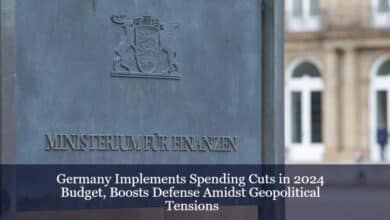Germany to cut 2024 spending over pandemic outlays and energy crisis
BERLIN: Germany plans to cut spending and borrowing substantially next year following massive outlays during the coronavirus pandemic and energy crisis, a draft of the budget showed Monday.

But the defense budget will hit a record high, and is expected to reach the two-percent NATO spending target, as Berlin invests in overhauling the military in response to Russia’s invasion of Ukraine, it showed. There have been drawn-out negotiations in the three-party ruling coalition over the budget due to cost cuts demanded by Finance Minister Christian Lindner, from the pro-business FDP party, but the cabinet is finally due to approve it Wednesday.
Europe’s biggest economy, which fell into recession at the turn of the year, is forecasting spending in 2024 of 445.7 billion euros ($486.2 billion), compared to 476.3 billion planned for this year. The reduction in new borrowing is even more drastic, with 16.6 billion euros planned for next year compared to 45.6 billion in 2023. Germany should thus comply with its constitutional “debt break” which limits new annual borrowing to 0.35 percent of gross domestic product a year, according to the draft. After being suspended from 2020 as Germany spent huge sums to tackle the coronavirus crisis, the budget rule came back into force this year.
But to ensure that the 2023 budget complied with the debt break, the government has had to resort to creating several special funds that are outside the official budget. They have been used in particular to help households and businesses cope with rising energy prices after Russia slashed crucial gas supplies to Europe amid the Ukraine war. The government will tap one of these funds to ensure it hits the NATO spending target in 2024, according to the draft budget. A sum of 51.8 billion euros will form the regular defense budget, a new high after about 50 billion in the 2023 budget.
There will be an additional 19.2 billion euros from a special, 100-billion-euro pot for the military that Chancellor Olaf Scholz established after the start of the Ukraine war. Meanwhile, German exports dipped in May after a small rebound in April, official data showed Tuesday, adding to a gloomier outlook for Europe’s biggest economy. Germany shipped goods worth 130.5 billion euros ($142 billion) in May, according to data published by federal statistics agency Destatis, down 0.1 percent compared with April. Imports rose by 1.7 percent to 116.1 billion euros in May, narrowing the trade surplus to 14.4 billion euros.
“Trade is no longer the strong resilient growth driver of the German economy it used to be,” said ING bank economist Carsten Brzeski. “Sluggish exports are no longer an exception but rather the new normal.” The weaker demand for “made in Germany” goods was led by a 3.6-percent fall in exports to the United States, Germany’s biggest export destination. Shipments to European Union countries dropped by 1.5 percent, but those to China ticked up by 1.6 percent. Most imports to Germany once again came from China, and were up 2.7 percent on the month before.
The German economy has been hit by a series of weak data in recent weeks, dampening hopes of a swift recovery after the energy crisis and high inflation tipped the country into a recession at the turn of the year. Leading economic institutes expect the German economy to shrink by 0.2 to 0.4 percent in 2023. “The ongoing weakening of export order books, the expected slowdown of the US economy, high inflation and high uncertainty will leave clear marks on German exports,” said Brzeski. – AFP.











